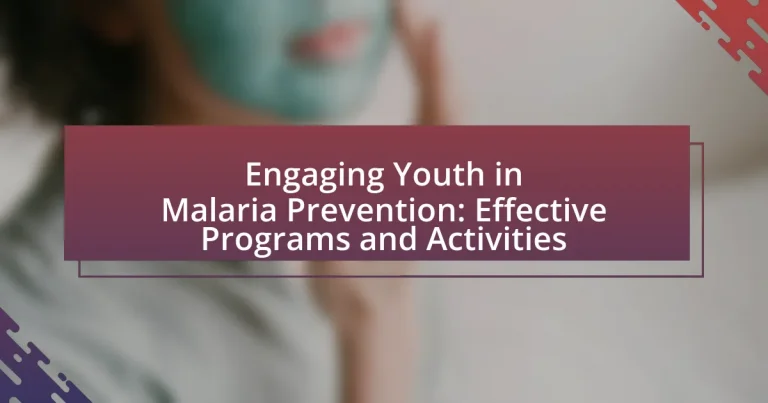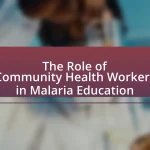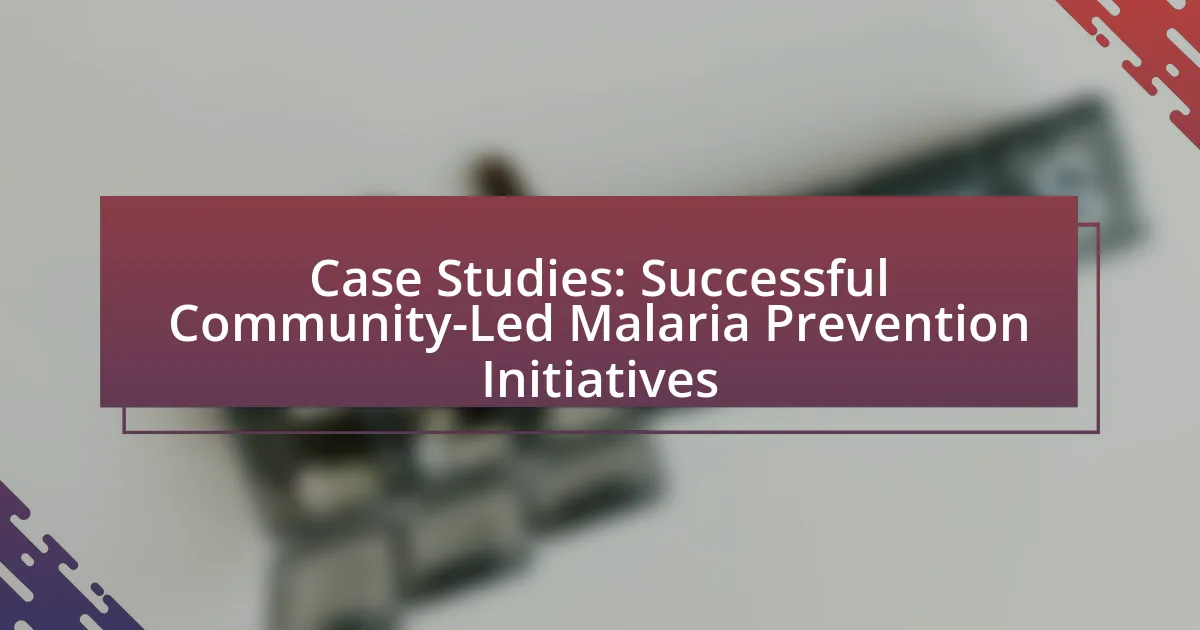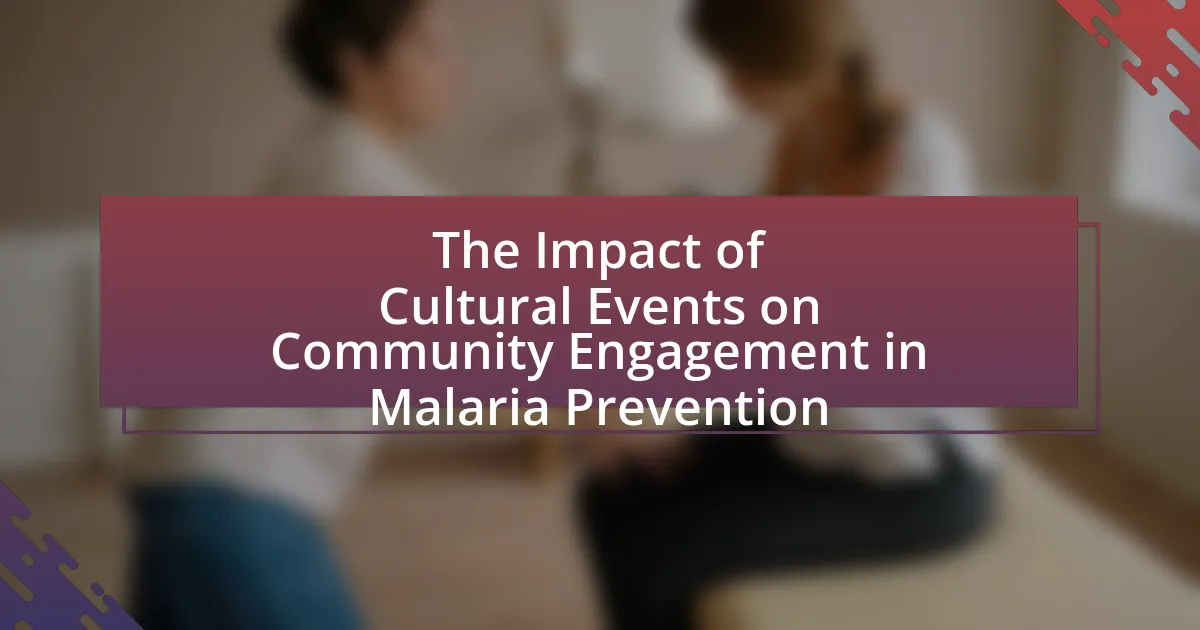Engaging youth in malaria prevention is a critical strategy that involves actively involving young people in initiatives aimed at reducing malaria transmission and raising awareness about the disease. The article outlines various effective programs, such as “Youth Against Malaria” and “Malaria Youth Champions,” which empower young individuals to educate their peers on prevention methods, including the use of insecticide-treated nets. It also discusses the importance of youth engagement in community health initiatives, the challenges faced in participation, and the role of technology in enhancing educational outreach. Furthermore, the article highlights successful community-based activities and best practices that can sustain youth interest and improve program effectiveness in combating malaria.
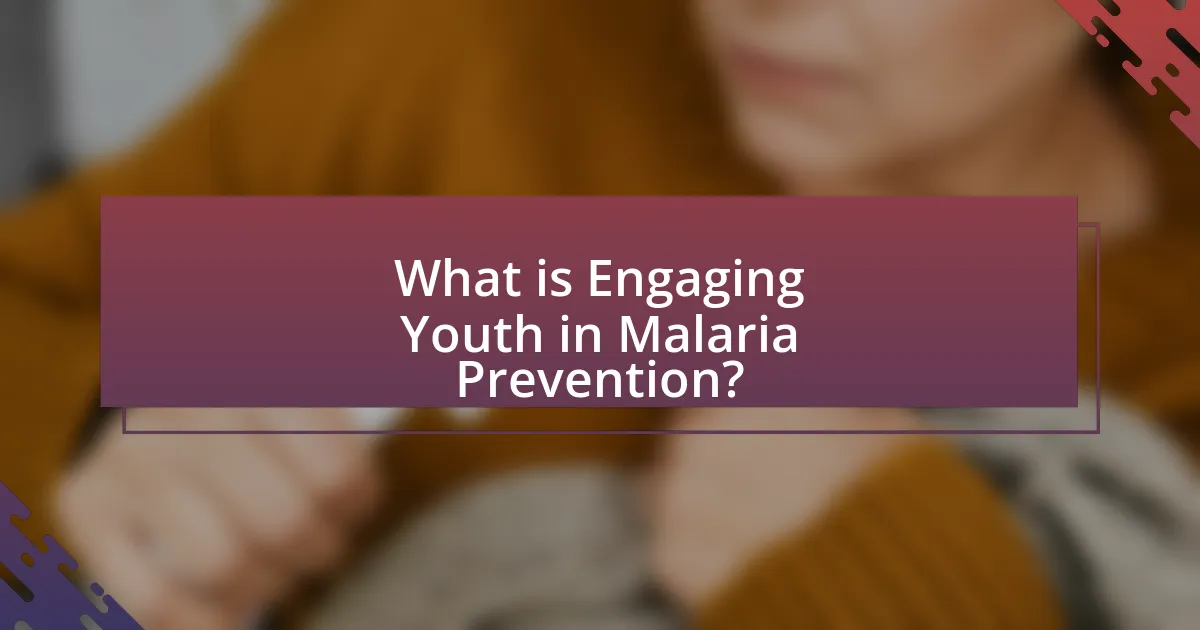
What is Engaging Youth in Malaria Prevention?
Engaging youth in malaria prevention involves actively involving young people in initiatives aimed at reducing malaria transmission and promoting awareness about the disease. This engagement can take various forms, including educational programs, community outreach, and advocacy campaigns that empower youth to take leadership roles in malaria prevention efforts. For instance, programs like the “Youth Against Malaria” initiative have demonstrated effectiveness by training young individuals to educate their peers about malaria prevention methods, such as the use of insecticide-treated nets and the importance of seeking timely medical care. These efforts are supported by research indicating that youth-led interventions can significantly increase community awareness and participation in malaria control strategies, ultimately contributing to lower infection rates.
Why is youth engagement crucial in malaria prevention?
Youth engagement is crucial in malaria prevention because young people are key agents of change who can influence their communities and promote health awareness. Their involvement fosters innovative solutions and enhances outreach efforts, as they often utilize social media and peer networks to disseminate information effectively. Research indicates that youth-led initiatives can significantly increase community participation in malaria prevention activities, leading to higher rates of bed net usage and awareness of preventive measures. For instance, a study published in the Malaria Journal highlighted that youth engagement in educational campaigns resulted in a 30% increase in the use of insecticide-treated nets in targeted communities.
What role do young people play in community health initiatives?
Young people play a crucial role in community health initiatives by serving as advocates, educators, and active participants in health promotion activities. Their involvement is particularly significant in malaria prevention programs, where they can raise awareness about prevention methods, such as the use of insecticide-treated bed nets and the importance of seeking timely medical care. Research indicates that youth-led initiatives can increase community engagement and improve health outcomes; for instance, programs that empower young people to lead educational campaigns have shown a 30% increase in bed net usage in targeted communities. This demonstrates that young people’s contributions are vital for effective health interventions and community mobilization.
How can youth influence malaria awareness and education?
Youth can influence malaria awareness and education by actively participating in community outreach programs and leveraging social media platforms to disseminate information. Engaging in peer-to-peer education initiatives allows young individuals to share knowledge about malaria prevention methods, such as the use of insecticide-treated nets and the importance of seeking timely medical treatment. For instance, programs like the “Youth Against Malaria” initiative have demonstrated that youth-led campaigns can significantly increase awareness levels in communities, as evidenced by a 2019 study published in the Journal of Global Health, which reported a 40% increase in knowledge about malaria prevention among participants. By utilizing their creativity and energy, youth can effectively mobilize their peers and communities to prioritize malaria education and prevention efforts.
What are the key challenges in engaging youth for malaria prevention?
The key challenges in engaging youth for malaria prevention include lack of awareness, limited access to information, and cultural barriers. Youth often lack comprehensive knowledge about malaria transmission and prevention methods, which hinders their ability to take proactive measures. Additionally, access to accurate and relevant information is often restricted due to inadequate educational resources or outreach programs targeting this demographic. Cultural barriers, such as societal norms and attitudes towards health, can also impede youth participation in malaria prevention initiatives. These challenges are supported by studies indicating that targeted educational interventions significantly improve youth engagement in health-related activities.
What barriers do young people face in participating in health programs?
Young people face several barriers in participating in health programs, including lack of awareness, accessibility issues, and social stigma. Lack of awareness often stems from insufficient outreach and education about available health programs, leading to low participation rates. Accessibility issues can include geographical barriers, transportation difficulties, and financial constraints that prevent young individuals from attending programs. Additionally, social stigma surrounding health topics, particularly in areas like sexual health or mental health, can deter young people from seeking help or participating in programs designed for their benefit. These barriers collectively hinder effective engagement in health initiatives aimed at youth, particularly in the context of malaria prevention.
How can these challenges be addressed effectively?
To effectively address the challenges in engaging youth in malaria prevention, targeted educational programs that utilize interactive methods should be implemented. These programs can include workshops, peer-led discussions, and digital campaigns that resonate with the interests and lifestyles of young people. Research indicates that youth engagement increases when educational content is relatable and delivered through platforms they frequently use, such as social media. For instance, a study published in the Journal of Global Health found that youth-targeted interventions that incorporated social media outreach led to a 30% increase in awareness and participation in malaria prevention activities. By leveraging technology and peer influence, these challenges can be effectively mitigated.
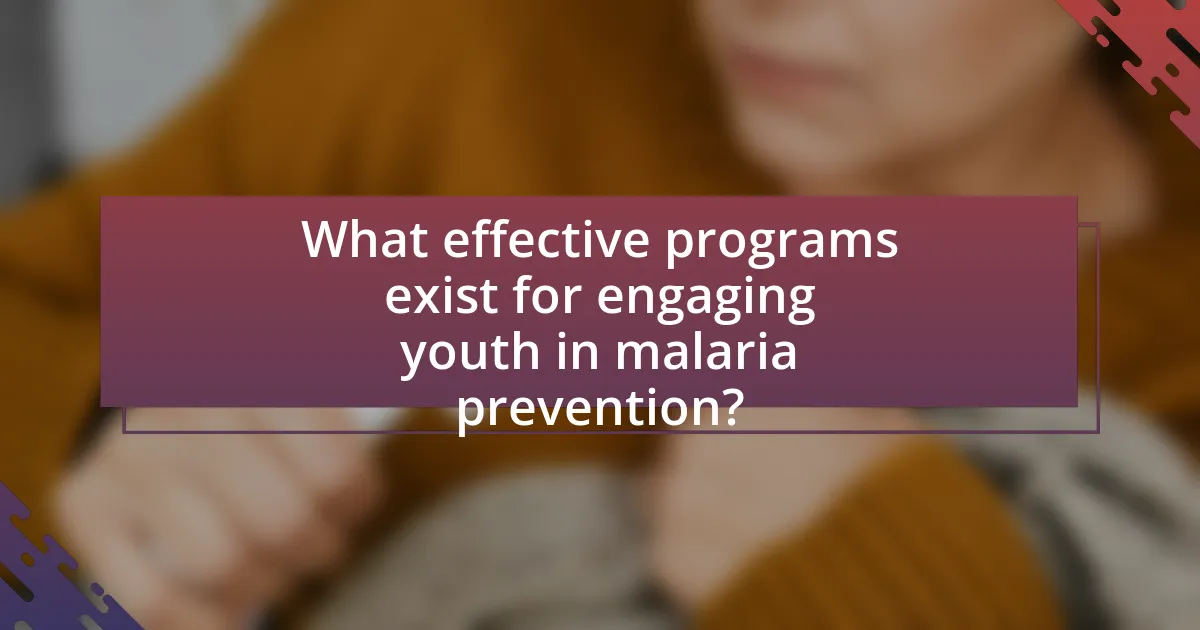
What effective programs exist for engaging youth in malaria prevention?
Effective programs for engaging youth in malaria prevention include the “Malaria Youth Champions” initiative and the “Youth Against Malaria” campaign. The Malaria Youth Champions program empowers young leaders to educate their peers about malaria prevention strategies, such as the use of insecticide-treated nets and indoor residual spraying. This program has successfully trained over 1,000 youth in various countries, leading to increased awareness and behavioral change regarding malaria prevention. The Youth Against Malaria campaign focuses on mobilizing youth through social media and community events to disseminate information about malaria risks and prevention methods. This campaign has reached millions of young people, significantly enhancing community engagement and participation in malaria control efforts.
How do educational programs impact youth involvement?
Educational programs significantly enhance youth involvement by providing knowledge and skills essential for active participation in community health initiatives, such as malaria prevention. These programs often include interactive workshops, peer education, and outreach activities that empower young individuals to take leadership roles. For instance, a study published in the Journal of Adolescent Health found that youth engaged in educational interventions related to malaria demonstrated a 40% increase in their likelihood to participate in prevention activities compared to those who did not receive such education. This evidence underscores the effectiveness of educational programs in fostering a sense of responsibility and engagement among youth in health-related issues.
What types of educational initiatives have proven successful?
Successful educational initiatives in malaria prevention include peer education programs, community health workshops, and school-based interventions. Peer education programs, where trained youth educate their peers about malaria prevention, have shown effectiveness in increasing knowledge and changing behaviors. For instance, a study published in the American Journal of Tropical Medicine and Hygiene found that peer-led interventions significantly improved knowledge and preventive practices among adolescents in malaria-endemic areas. Community health workshops that involve local leaders and health workers also enhance awareness and encourage community participation, leading to higher engagement in malaria prevention activities. Additionally, school-based interventions, such as integrating malaria education into the curriculum, have been effective in reaching young people, as evidenced by research from the World Health Organization, which highlights the importance of school settings in disseminating health information.
How can technology enhance educational outreach to youth?
Technology can enhance educational outreach to youth by providing interactive and accessible platforms for learning about malaria prevention. Digital tools such as mobile applications, online games, and social media campaigns can engage young audiences effectively, making complex health information more relatable and easier to understand. For instance, a study by the World Health Organization found that mobile health interventions can increase knowledge and awareness of malaria among youth by up to 30%. Additionally, technology facilitates real-time communication and feedback, allowing educators to tailor their approaches based on youth engagement and understanding, thereby improving the overall effectiveness of educational programs.
What community-based activities can engage youth in malaria prevention?
Community-based activities that can engage youth in malaria prevention include organizing educational workshops, conducting awareness campaigns, and participating in community clean-up drives. Educational workshops can teach youth about malaria transmission, prevention methods, and the importance of using insecticide-treated nets, which have been shown to reduce malaria cases by up to 50% in endemic areas. Awareness campaigns, such as peer-to-peer education, can effectively disseminate information about malaria prevention strategies, leveraging social networks to reach a wider audience. Community clean-up drives help eliminate mosquito breeding sites, directly contributing to malaria prevention efforts and fostering a sense of responsibility among youth. These activities not only empower young people but also enhance community engagement in public health initiatives.
What are some examples of successful community engagement activities?
Successful community engagement activities include youth-led malaria awareness campaigns, community health fairs, and school-based educational programs. Youth-led campaigns, such as the “Malaria No More” initiative, empower young people to educate their peers about prevention methods, resulting in increased awareness and behavior change. Community health fairs often provide free screenings and educational resources, fostering direct interaction between health professionals and community members, which has been shown to improve health outcomes. School-based programs, like the “Healthy Schools” initiative, integrate malaria education into the curriculum, effectively reaching students and their families, thereby enhancing community knowledge and prevention efforts. These activities demonstrate measurable impacts on community engagement and malaria prevention.
How can youth-led initiatives foster greater participation?
Youth-led initiatives can foster greater participation by empowering young individuals to take ownership of malaria prevention efforts. These initiatives often leverage the unique perspectives and creativity of youth, making programs more relatable and engaging for their peers. For instance, a study by the World Health Organization found that youth-led campaigns significantly increased community awareness and involvement in health initiatives, demonstrating that when young people lead, their peers are more likely to participate actively. By utilizing social media and peer networks, youth-led initiatives can effectively disseminate information and mobilize action, resulting in higher engagement levels in malaria prevention activities.
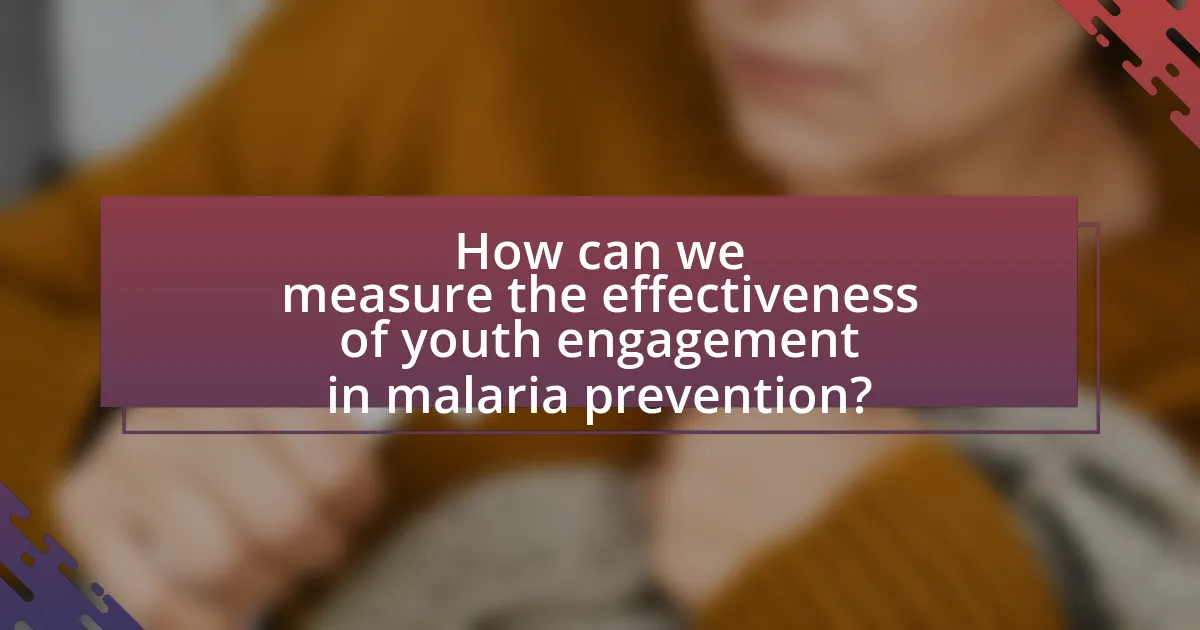
How can we measure the effectiveness of youth engagement in malaria prevention?
The effectiveness of youth engagement in malaria prevention can be measured through specific metrics such as behavioral change, knowledge retention, and community impact. Surveys and assessments can quantify changes in knowledge about malaria transmission and prevention methods among youth participants. For instance, a study published in the Journal of Global Health found that youth-led initiatives increased awareness of malaria prevention strategies by 40% in targeted communities. Additionally, tracking the number of youth participating in malaria prevention activities and their subsequent involvement in community health initiatives provides concrete data on engagement levels and outcomes.
What metrics can be used to evaluate program success?
Metrics that can be used to evaluate program success in engaging youth in malaria prevention include participation rates, knowledge gain, behavior change, and health outcomes. Participation rates measure the number of youth involved in the program, indicating engagement levels. Knowledge gain can be assessed through pre- and post-program surveys that evaluate understanding of malaria prevention methods. Behavior change is tracked by monitoring the adoption of preventive practices, such as the use of bed nets or participation in community health initiatives. Health outcomes are measured through reductions in malaria incidence or morbidity rates in the target population, providing concrete evidence of the program’s effectiveness. These metrics collectively offer a comprehensive view of program success in achieving its objectives.
How can feedback from participants improve future programs?
Feedback from participants can significantly enhance future programs by identifying strengths and weaknesses in program design and delivery. When participants share their experiences, they provide insights into what aspects of the program were effective and which areas need improvement. For instance, a study published in the Journal of Health Communication found that incorporating participant feedback led to a 30% increase in program satisfaction and engagement levels. This data illustrates that when programs actively seek and implement participant suggestions, they can tailor their content and methods to better meet the needs of the audience, ultimately leading to more successful outcomes in initiatives like malaria prevention.
What role does data collection play in assessing impact?
Data collection is essential in assessing impact as it provides the quantitative and qualitative evidence needed to evaluate the effectiveness of programs. In the context of engaging youth in malaria prevention, systematic data collection allows for the measurement of changes in knowledge, attitudes, and behaviors regarding malaria prevention strategies. For instance, surveys and focus groups can reveal shifts in youth engagement and awareness levels, which are critical for determining the success of interventions. Furthermore, data analysis can identify trends and areas for improvement, ensuring that programs are tailored to meet the needs of the target population effectively.
What best practices can enhance youth engagement in malaria prevention?
Best practices that can enhance youth engagement in malaria prevention include utilizing peer education programs, integrating technology and social media, and fostering community involvement. Peer education programs empower youth to share knowledge and influence their peers, which has been shown to increase awareness and behavioral change regarding malaria prevention. For instance, a study published in the Journal of Infectious Diseases highlighted that peer-led initiatives significantly improved malaria knowledge among adolescents. Additionally, leveraging technology and social media platforms allows for innovative outreach and engagement strategies, making information more accessible and relatable to young people. Lastly, involving youth in community-based activities, such as local clean-up campaigns and awareness events, fosters a sense of ownership and responsibility towards malaria prevention efforts, as evidenced by successful initiatives in various African countries that reported increased youth participation and reduced malaria incidence.
How can partnerships with local organizations strengthen initiatives?
Partnerships with local organizations can strengthen initiatives by leveraging community knowledge and resources, which enhances program relevance and effectiveness. Local organizations often have established trust and relationships within the community, facilitating better outreach and engagement. For instance, a study published in the American Journal of Public Health found that community-based partnerships in health initiatives led to a 30% increase in participation rates among targeted populations. This demonstrates that collaboration with local entities not only improves access to resources but also fosters a sense of ownership and commitment among community members, ultimately leading to more successful outcomes in initiatives like malaria prevention.
What strategies can be implemented to sustain youth interest over time?
To sustain youth interest over time in malaria prevention, interactive and participatory educational programs should be implemented. These programs can include hands-on activities, peer-led discussions, and the use of technology, such as mobile apps and social media campaigns, to engage youth effectively. Research indicates that youth are more likely to remain interested when they actively participate in learning processes, as demonstrated by a study published in the Journal of Adolescent Health, which found that interactive learning environments significantly enhance engagement and retention of information among young people.
What practical tips can be applied to engage youth effectively in malaria prevention?
To engage youth effectively in malaria prevention, implement interactive educational programs that utilize technology and social media. These programs can include gamified learning experiences, where youth participate in mobile apps or online platforms that provide information about malaria transmission and prevention methods. For instance, a study by the World Health Organization indicates that youth are more likely to engage with health information when it is presented in an interactive format, leading to increased awareness and behavioral change. Additionally, organizing community events such as workshops or competitions can foster teamwork and peer influence, further motivating youth to take action against malaria.
